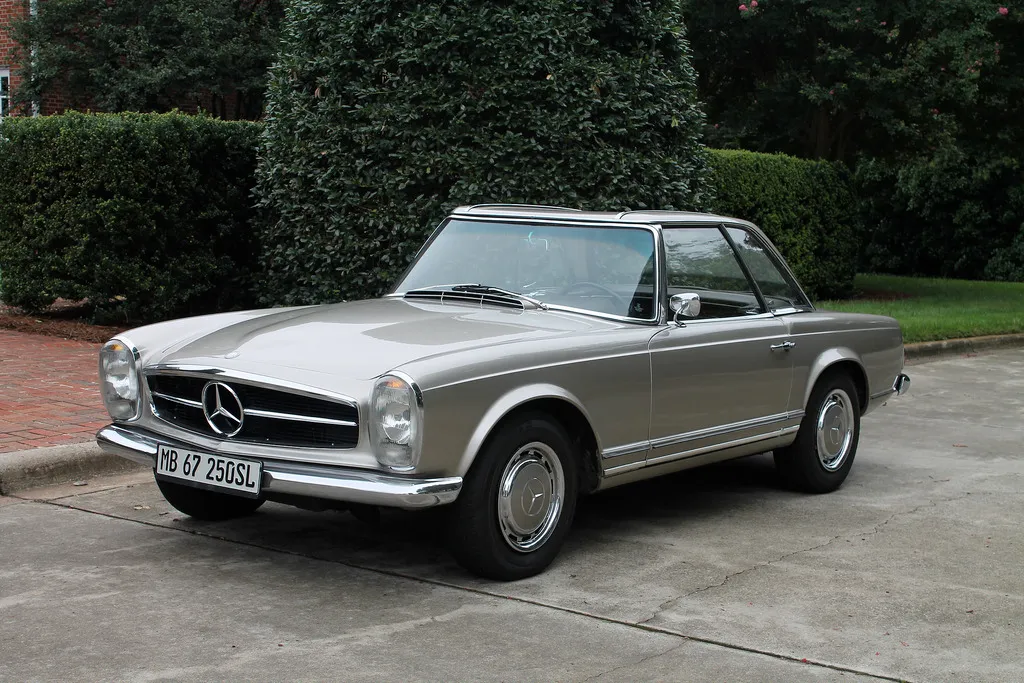
Mercedes W113
An in-depth overview of the distinguished Mercedes W113 from the #1 Vintage Mercedes Parts Shop
A Classic Icon of Automotive Design The Mercedes-Benz W113, commonly referred to as the “Pagoda” due to its distinctive concave hardtop roof, remains an emblem of classic automotive design and engineering excellence. Introduced in 1963 and produced until 1971, the W113 not only marked a significant technical and aesthetic evolution in the sports car category but also established new standards in safety and performance that influenced the entire auto industry. This beauty is still so popular that classic Mercedes parts sellers keep each and every part needed for it in stock regularly.
Origins and Design
The Mercedes W113 was unveiled at the 1963 Geneva Motor Show, replacing the outgoing 190SL and 300SL models. The car was designed by Paul Bracq and Béla Barényi, who are credited with pioneering some of the safety features now standard in modern vehicles, such as crumple zones and a rigid passenger cell. The “Pagoda” nickname derives from the design of the removable hardtop, which was wider at its base than at the top, a feature that provided improved roll-over protection and an undeniably unique aesthetic. Components for this hardtop design are available online by sellers of classic Mercedes parts,
Models and Specifications
The W113 was released in three primary models: the 230SL, 250SL, and 280SL, each named according to their engine displacement. These models featured a straight-six engine and came with either a four-speed manual or an automatic transmission. Over the years, Mercedes-Benz made subtle improvements in performance and comfort. The 230SL had a 2.3-liter engine producing 150 horsepower, which was considered impressive for its time. It was succeeded by the 250SL in 1967, which featured an upgraded 2.5-liter engine and improved rear disc brakes. The final model, the 280SL, was introduced in 1968 and equipped with a 2.8-liter engine, producing up to 170 horsepower. Classic Mercedes parts will vary from model to model. Here are some more specific stats about each model of the Mercedes W113:
230SL (1963-1967)*
- Engine: 2.3-liter inline-six
- Power: 150 hp (112 kW)
- Torque: 196 Nm (145 lb-ft)
- Transmission Options: 4-speed manual – 5-speed manual (optional) – 4-speed automatic
- Top Speed: Approximately 200 km/h (124 mph)
- Acceleration (0-60 mph): 11 seconds
- Production Numbers:
- Around 19,831 units
250SL (1967 only)
- Engine: 2.5-liter inline-six
- Power:150 hp (112 kW) (same as 230SL but with more torque)
- Torque: 216 Nm (159 lb-ft)
- Transmission Options: 4-speed manual – 4-speed automatic – 5-speed manual (very rare)
- Top Speed: Approximately 200 km/h (124 mph)
- Acceleration (0-60 mph): 10 seconds
- Production Numbers: Approximately 5,196 units
280SL (1968-1971)
- Engine: 2.8-liter inline-six
- Power: 170 hp (127 kW)
- Torque: 240 Nm (177 lb-ft)
- Transmission Options: 4-speed manual – 5-speed manual (optional) – 4-speed automatic
- Top Speed: Over 200 km/h (125 mph)
- Acceleration (0-60 mph): 9 seconds
- Production Numbers: Around 23,885 units
General Features For All Models – Information about Classic Mercedes Parts:
- Body Style: Two-seater convertible with a detachable hardtop and soft-top
- Construction: Unitary steel frame, with front suspension by double wishbones and coil springs, rear swing axles with coil springs
- Brakes: Disc brakes at the front and rear, with power assist
- Safety Features: Rigid passenger cell, front and rear crumple zones, improved rollover protection thanks to the unique hardtop design
Performance and Legacy
The W113 was not just a beautiful car; it was also a performer. With a top speed of around 200 km/h (124 mph) and sophisticated suspension systems, the Pagoda combined sportiness with luxury, making it a favorite among affluent buyers and car enthusiasts alike. The model’s balance of performance, comfort, and safety was unprecedented at the time and set a new benchmark for sports cars. Today, the W113 is highly sought after by collectors due to its iconic design, advanced engineering for its era, and relatively limited production numbers. Mercedes-Benz manufactured just under 49,000 units across all three models, which contributes to the car’s rarity and enduring appeal. To this day, all classic Mercedes parts that one would need to keep this beauty in shape are available!
Cultural Impact
The Mercedes W113 has appeared in numerous films and continues to be a symbol of 1960s luxury and style. Its ownership by celebrities and use in high-profile events have cemented its status as a classic and a collector’s dream. ## Conclusion The Mercedes W113 Pagoda represents a pivotal moment in automotive history. It exemplifies how design and technology can come together to create not just a car, but a lasting legacy. Today, it stands not only as a collector’s item but also as a milestone in the evolution of car design and safety features, continuing to inspire admiration and passion among car enthusiasts around the world. There are many online shops that carry classic Mercedes parts for this model so enthusiasts can keep this iconic car on the road! Whether seen on the road or showcased in a museum, the Pagoda remains a testament to the enduring legacy of Mercedes-Benz in the automotive industry.

